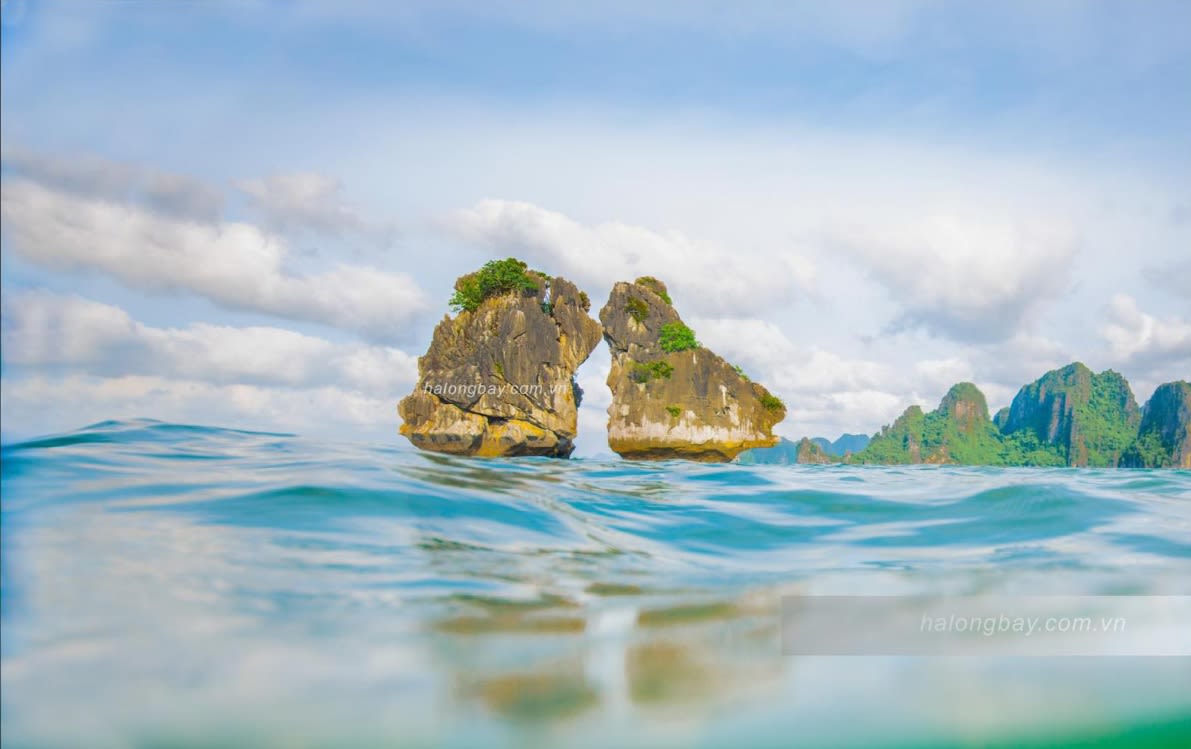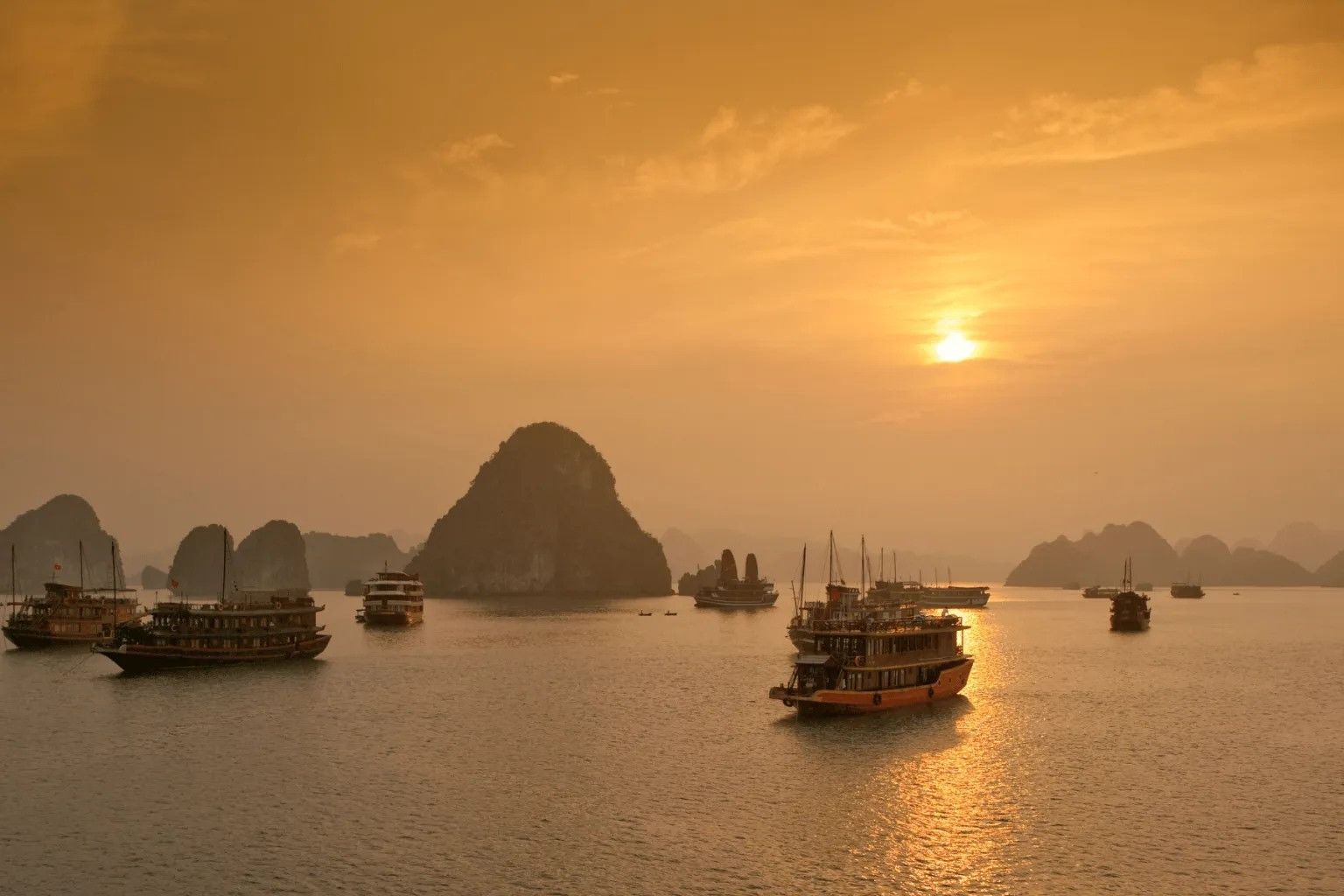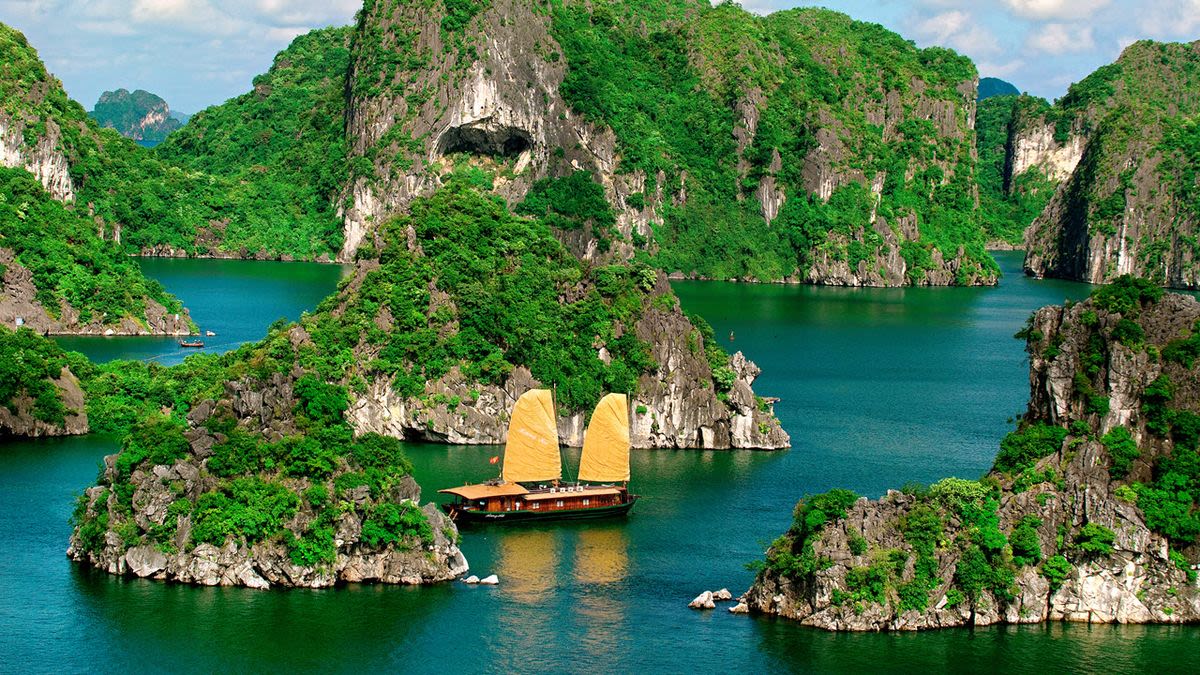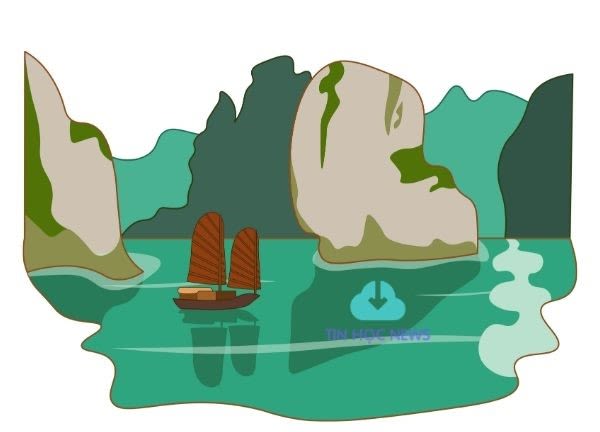
Ha Long
The 30-year journey of a
World Heritage site

Nearly 30 years ago, on December 17, 1994, Vietnam received its first World Natural Heritage recognition with Ha Long Bay. The unique and exceptional values of this naturally endowed scenic spot, which was formed millions of years ago, have brought pride but also great responsibility to Vietnam in general and Quang Ninh Province in particular.
Ha Long Bay — A natural wonder rising to the sky

Described by Nguyen Trai as “a natural wonder rising to the sky”, Ha Long Bay has twice been inscribed as a UNESCO World Natural Heritage Site, first in 1994 for its outstanding global aesthetic value, and also in 2000 for its geological and geomorphological values.
In September 2023, Ha Long Bay was once again recognised by UNESCO as a World Natural Heritage Site, this time with its boundaries expanded to include the Cat Ba Archipelago (Hai Phong), becoming Vietnam’s first inter-provincial World Heritage Site.
The stunning natural landscape, along with its special cultural, historical and biodiversity values, helped Ha Long Bay achieve the UNESCO recognition. The journey to each recognition was a long process with many challenges, but it has also been a glorious and proud journey for both Quang Ninh Province and Vietnam as a whole.
Two years of preparation and 100% approval
Going back to 30 years ago, recognising Ha Long Bay’s global value and desiring the world’s recognition, in 1991 the Vietnamese government approved the preparation of Ha Long Bay’s nomination dossier for submission to the World Heritage Committee for review. This was the crucial first step in affirming Ha Long Bay’s stature and value on an international scale.
To prepare the nomination dossier, the Ha Long Bay Management Board collaborated with various agencies, organisations and experts, both domestic and international, to carry out numerous tasks: investigating, researching, collecting, synthesising and compiling scientific information about Ha Long Bay; developing conservation and sustainable development plans; and designing and printing the nomination dossier according to UNESCO requirements. This work was carried out continuously over two years (1991-1993). In 1993, Vietnam officially submitted the nomination dossier to UNESCO.
After receiving the Ha Long Bay nomination dossier, UNESCO sent several expert teams to Quang Ninh to survey, instruct, research and evaluate the dossier on-site. The experts also provided many recommendations to help Vietnam further improve the nomination dossier. They all gave positive feedback, affirming Ha Long Bay’s global value.
Based on the scientific dossier on Ha Long Bay prepared by the Ministry of Culture and Information, the Quang Ninh Provincial People’s Committee and Vietnam’s National UNESCO Committee since 1992, along with evaluation opinions from international expert organisations, on December 14, 1994, at the famous Le Meridien Hotel in Phuket (Thailand), during its 18th session, the World Heritage Committee recognised Ha Long Bay as a World Natural Heritage site. The recognition was based on its outstanding global aesthetic value under the International Convention Concerning the Protection of World Natural and Cultural Heritage, with 100% approval from committee members.
The ceremony to receive the World Natural Heritage title in 1994. (Photo: halongbay.com.vn)
The ceremony to receive the World Natural Heritage title in 1994. (Photo: halongbay.com.vn)
Accordingly, to be inscribed on UNESCO’s World Natural Heritage List for aesthetic value, Ha Long Bay met the criterion (vii) of UNESCO, which states that the area must be superlative natural phenomena or areas of exceptional natural beauty and aesthetic importance, contain superlative natural phenomena or areas of exceptional natural beauty and aesthetic importance., containing areas that are unique or outstanding in terms of natural beauty or aesthetic importance due to related geological or biological processes.
As a UNESCO-recognised world heritage for aesthetic value, Ha Long Bay is famous for its unique and mysterious landscape with thousands of limestone islands forming overlapping and vivid scenes. It is also home to majestic caves, hiding diverse and beautiful stalactites. Not only does it feature a rich and diverse ecosystem, with many rare and endemic species of flora and fauna, Ha Long Bay is also a place that records the legends, history and culture of the Vietnamese people, creating a natural heritage with high cultural value.
Ha Long Bay’s recognition as a World Heritage Site at the 18th Session of the World Heritage Council on December 14, 1994, “has raised the value of this heritage, placing it in global arena. Not only is this an event of great cultural significance but also of long-term political and economic significance for the development of the country.
This is an event of great significance to the whole country. One year after the Complex of Hue Monuments was recognised as a World Cultural Heritage at the 17th meeting of the World Heritage Committee in December 1993, Ha Long Bay is the second site in our country to be listed as a World Heritage as well as the first World Natural Heritage of Vietnam.
The Vietnam National Commission for UNESCO’s submission letter to the prime minister, dated December 27, 1994, stated that Ha Long Bay’s recognition as a World Heritage Site at the 18th Session of the World Heritage Council on December 14, 1994, “has raised the value of this heritage, placing it in global arena. Not only is this an event of great cultural significance but also of long-term political and economic significance for the development of the country.”
There is no karst limestone area in the sea as vast and majestic as this.
After Ha Long Bay was recognised as a World Natural Heritage for its aesthetic value, the bay’s management board has actively conducted researches on other values of the bay.
According to Nguyen Van Tuan, former Head of the Ha Long Bay Management Board, in his meeting with Dr. Hans Friederich, Director of the International Union for Conservation of Nature (IUCN) in Vietnam in 1999, the IUCN official hailed that there is no karst limestone area in the world that is as large and majestic as Ha Long Bay, stressing that the bay completely deserves its title as a world heritage site in terms of geology and geomorphology.
Being aware of the outstanding global geological and geomorphological value of Ha Long Bay, the bay’s management board wants to gain UNESCO’s recognition for this additional criterion. To realise this goal, the management board was requested to focus on clarifying the fundamental values of Ha Long Bay in terms of aesthetic landscape, geology and geomorphology, cultural history, and biodiversity, especially in terms of geology and geomorphology. Previously, there had been many research projects on this topic, but they were still small and unsynchronised.
Therefore, a series of tasks such as investigating, researching, collecting, and compiling scientific information about Ha Long Bay from a new perspective — supplementing and editing the dossier according to UNESCO's requirements — were carried out meticulously and carefully, based on the experience gained from the making of the previous dossier. These tasks started in 1998. To strengthen the dossier, the Ha Long Bay Management Board proposed that UNESCO support a small project to invite international and domestic experts to Ha Long to conduct surveys and make assessments.
To be recognised as a World Natural Heritage site for its geological and geomorphological value, Ha Long Bay had to meet UNESCO’s criteria, which include: representing significant stages in Earth’s history, including traces of life; exemplifying ongoing geological processes or existing formations; showcasing exceptional or unique geological and geomorphological features; and representing outstanding examples of ongoing geological processes in ecosystems and biological communities.
Following a survey of Ha Long Bay, Professor Tony Waltham, from Nottingham Trent University in the UK, submitted a geological and geomorphological evaluation report on Ha Long Bay to the Quang Ninh Provincial People’s Committee, the Ha Long Bay Management Board, UNESCO’s Hanoi Office, and the IUCN. He also sent the report to the World Heritage Centre in Paris, stating: “There’s nothing more to say; we can affirm that Ha Long Bay is a globally significant karst landscape with a strong foundation in geological science… Alongside its scenic value, the geological significance of Ha Long Bay must be preserved for the benefit of humanity.”
There’s nothing more to say; we can affirm that Ha Long Bay is a globally significant karst landscape with a strong foundation in geological science… Alongside its scenic value, the geological significance of Ha Long Bay must be preserved for the benefit of humanity.
Upon receiving Professor Waltham’s report, on February 25, 1999, the World Heritage Centre in Paris sent a letter to the Quang Ninh People’s Committee, the Vietnam National Commission for UNESCO, and the Ha Long Bay Management Board, requesting that they expedite preparations to submit a dossier to UNESCO for the recognition of Ha Long Bay’s outstanding global geological value as a karst region. The dossier was submitted to UNESCO within the same year.
Ha Long Bay was recognised by UNESCO as a World Heritage site for its geological and geomorphological value due to the development of karst limestone formations over billions of years. These limestone features are the result of Earth’s tectonic, deformation, uplift, erosion, weathering, and sea level changes. Ha Long Bay also represents one of the areas where sea level changes have occurred throughout Earth’s evolutionary history from the Cretaceous period to the present. Thus, Ha Long Bay serves as a living record of global climate change. It also exemplifies the interaction between geological and biological processes, creating a rich and diverse ecosystem.

At the 23rd session of the World Heritage Committee held in Marrakech, Morocco, in early December 1999, the committee officially accepted Ha Long Bay’s dossier for assessment, and in 2000, it confirmed Ha Long Bay’s geological value.
Following the plan, in March 2000, Professor Elery Hamilton Smith, an Australian expert and member of the International Union for Conservation of Nature (IUCN), was sent to Ha Long to verify the authenticity of the dossier, evaluate its geological value, review the management status, and provide recommendations.
The ceremony celebrating the second recognition of Ha Long Bay as a World Natural Heritage Site. (Photo: halongbay.com.vn)
The ceremony celebrating the second recognition of Ha Long Bay as a World Natural Heritage Site. (Photo: halongbay.com.vn)
In his assessment report, Professor Elery Hamilton Smith stated that this nomination of Ha Long Bay in the World Heritage List under criterion as an area with exceptional ongoing geological processes and remarkable geomorphological characteristics, and under criterion as an area with outstanding natural scenery and exceptional aesthetic value.
In July 2000, at its mid-year session in Paris, the World Heritage Centre officially recommended that the World Heritage Committee recognise Ha Long Bay as a World Natural Heritage Site for its outstanding geological and geomorphological values.
On December 2, 2000, at the 24th session of the World Heritage Committee held in Cairns, Australia, after listening to the presentation of the World Heritage Centre and the assessment of IUCN, the World Heritage Committee officially decided to recognise Ha Long Bay as a World Natural Heritage for the second time according to criterion (i) of the World Heritage Convention.
HA
LONG
BAY

A perfect example of a unique ecosystem preserved
Ha Long Bay is one of the most famous heritage sites in the world. As early as 1993, when evaluating the nomination dossier of Ha Long Bay, the International Union for Conservation of Nature (IUCN) recommended: “It is necessary to add to this area the rocky islands adjacent to Cat Ba Island, which are part of the National Park but are found in the border area of Hai Phong.”
The expansion of the Ha Long Bay World Natural Heritage to include the Cat Ba Archipelago will increase the inherent value of the heritage, which is demonstrated through the harmony of landscape, geology, geomorphology, ecosystem, and diversity of flora and fauna. The outstanding global values of the area are determined to include physical and biological formations, geological and geographical formations, and habitats of threatened flora and fauna from aesthetic, scientific, and conservation perspectives.
As recommended, in 2013, the nomination dossier for the Cat Ba Archipelago as a World Natural Heritage according to the criteria of biodiversity and ecosystem (criteria ix and x) was sent to the World Heritage Centre. After the appraisal process, IUCN drafted Decision No. WHC-14/38.COM/INF.8B for the World Heritage Committee to adopt at the 38th Session in Qatar in 2014. The document stated: “The Member State considers the possibility of proposing an extension to Ha Long Bay, according to criteria (vii) and (viii) and possibly criterion (x), to include the Cat Ba Archipelago.”
Since then, the implementation of conservation activities and research to prepare a dossier for the nomination of Ha Long Bay - Cat Ba Archipelago as a world heritage site has continued to be promoted.
In September 2016, based on proposals from localities and advice from the Ministry of Culture, Sports and Tourism, the prime minister agreed to allow Hai Phong City to preside over and coordinate with Quang Ninh Province to prepare a dossier on extending Ha Long Bay to include Cat Ba Archipelago for submission to the prime minister for consideration and approval to UNESCO. At the same time, the Ministry of Culture, Sports and Tourism was assigned to guide Hai Phong City in building the dossier of the World Natural Heritage of Ha Long Bay - Cat Ba Archipelago in accordance with the provisions of the law on cultural heritage and related regulations.
The process of building the dossier also encountered many difficulties, with recommendations and comments from both UNESCO and IUCN. However, with the spirit and responsibility of the specialised agencies of the Ministry of Culture, Sports and Tourism and the determination of Hai Phong City, Quang Ninh Province, and the Vietnam National Commission for UNESCO, in early 2021, the dossier of Ha Long Bay - Cat Ba Archipelago was edited and completed according to the recommended content and then submitted to UNESCO.
The moment when Abdulelah Al-Tokhais, Chairperson of the 45th session of the World Heritage Committee, Saudi Arabia, rapped the gavel to approve the dossier of Ha Long Bay - Cat Ba Archipelago at 5:39 p.m. on September 16, 2023 (local time). (Photo: bvhttdl.gov.vn)
The moment when Abdulelah Al-Tokhais, Chairperson of the 45th session of the World Heritage Committee, Saudi Arabia, rapped the gavel to approve the dossier of Ha Long Bay - Cat Ba Archipelago at 5:39 p.m. on September 16, 2023 (local time). (Photo: bvhttdl.gov.vn)
During the 45th session of the World Heritage Committee held in Riyadh, Saudi Arabia, from September 10, 2023, the delegation from Vietnam’s Ministry of Culture, Sports, and Tourism, along with the Ambassador and Head of Vietnam’s Permanent Delegation to UNESCO in France, and representatives from Hai Phong and Quang Ninh provinces, met with UNESCO’s specialised agencies, the Director of the World Heritage Centre, the Director-General of ICOMOS, the Director of the IUCN World Heritage Programme, and the Head of the Nominations Unit at the World Heritage Centre, as well as 21 member countries of the World Heritage Committee. These meetings aimed to provide information, explanations, and clarifications, expressing Vietnam’s perspective and commitment to managing, protecting, and promoting the heritage value of the sites after their inscription on the World Heritage List.
Through this process, international experts, scientists, and member countries of the World Heritage Committee highly appreciated the heritage values and supported the nomination of Ha Long Bay - Cat Ba Archipelago as a World Natural Heritage Site.
On September 16, 2023, in Riyadh, Saudi Arabia, during the 45th session of the UNESCO World Heritage Committee, the nomination file was approved, officially recognising the Ha Long Bay - Cat Ba Archipelago as a World Natural Heritage Site. With this UNESCO recognition, Ha Long Bay - Cat Ba Archipelago became Vietnam’s first inter-provincial world heritage site.
During the 20th anniversary of Ha Long Bay’s second designation as a World Natural Heritage Site, Katherine Muller-Marin, UNESCO’s Chief Representative in Vietnam, expressed: “The beauty of Ha Long Bay symbolises the successful efforts to preserve and promote this natural heritage across the country and the world, serving as a perfect example of a unique ecosystem preserved here.”
She stated, “Ha Long Bay, with its countless limestone mountains, caves, arches, and small islands rising from crystal-clear waters amid stunning natural surroundings, enchants all who come to Vietnam, offering unforgettable experiences and memories.”
Recognising Ha Long Bay - Cat Ba Archipelago as a World Natural Heritage Site not only creates Vietnam’s first unique inter-regional World Heritage but also adds value to this magnificent and vast heritage area. Being recognised by UNESCO as a World Natural Heritage Site three times is the clearest testament to Ha Long Bay’s outstanding global values.
---
Katherine Muller-Marin, UNESCO Chief Representative in Vietnam

Preserving heritage for generations to come
For nearly 30 years since its first recognition as a World Natural Heritage Site, Quang Ninh has always regarded Ha Long Bay as a treasured gift of nature, a significant driver for tourism development and economic restructuring. Therefore, Quang Ninh Province has consistently prioritised preserving and promoting heritage values.
Ha Long Bay is renowned for the majestic beauty of its islands and waters and as a vast geological museum, preserving crucial traces of the area’s formation, movement, and development of the Earth’s crust. Over the years, Quang Ninh has implemented many effective measures to protect and ensure the integrity of Ha Long Bay following the World Heritage Convention, UNESCO’s policies on sustainable development, and Vietnam’s laws.
Quang Ninh Province commits and affirms that it will do its utmost to best preserve and promote the effectiveness of the World Natural Wonder Heritage Ha Long Bay for future generations.
At the 20th Anniversary of Ha Long Bay being honoured, Vu Thi Thu Thuy, Vice Chairman of the Provincial People's Committee, affirmed: “Pride and honour are associated with responsibility towards the people of the whole country and the international community. Quang Ninh Province commits and affirms that it will do its utmost to best preserve and promote the effectiveness of the World Natural Wonder Heritage Ha Long Bay for future generations.”
In parallel with regularly organising investigations, research, and clarification as a basis for proposing management and protection solutions to prevent risks of encroachment on the heritage, Quang Ninh Province has established a conservation area to preserve its biodiversity values; delimited forests on limestone mountains and mangrove forests to be recognised as special-use forests to protect the landscape and preserve rare genetic resources; relocated 354 households with nearly 2,000 people in 7 fishing villages to live in resettlement areas in 2014, with the goal of stabilising fishermen’s lives and reducing environmental pressure on the bay; and imposed standards on wastewater and waste at tourist boats, tourist attractions, and residential areas along the Bay’s shore.
Specifically, since 2019, the movement entitled “Ha Long Bay without plastic waste” has been launched and effectively implemented by the Bay Management Board, receiving active participation from businesses and people. The landscape environment and ecological environment of the bay are managed in the direction of good control of waste sources, while socio-economic activities are strictly managed and increasingly put into order.
With efforts in managing, preserving and promoting the value of the heritage, Ha Long Bay has become a bright spot on the tourism map of Vietnam and the region. In recent years, the bay has always been present in the rankings and votes of attractive tourist destinations voted by many international organisations, media agencies, and prestigious websites in the world (Vietnam’s leading tourist area; Vietnam’s leading destination, one of the 10 most impressive UNESCO heritages in Asia, one of the 10 most ideal tourist attractions in Southeast Asia, one of the 24 tourist destinations worth visiting in 2024, etc.).
Ha Long Bay - Cat Ba Archipelago
Ha Long Bay - Cat Ba Archipelago was recognised by UNESCO as a World Heritage Site because it contains areas of natural beauty including limestone islands covered with vegetation and limestone pinnacles rising above the sea along with related karst features such as domes and caves. The spectacular untouched landscape features islands covered with vegetation, salt lakes, and limestone pinnacles with vertical cliffs rising above the sea.
With 1,133 limestone islands of various shapes and sizes, including 775 limestone islands in Ha Long Bay and 358 limestone islands in the Cat Ba archipelago, covered with rich vegetation on the sparkling emerald water surface, Ha Long Bay - Cat Ba Archipelago appears like a chessboard of precious stones, with peaceful, smooth, white sand beaches.
Ha Long Bay - Cat Ba Archipelago is considered a geological museum, containing heritages with outstanding global value, witnessing characteristic changes in the history of the earth's development, evidenced by the presence of primeval forests, bays and islands.
The intact nature reserve — featuring a majestic karst limestone mountain system, rich cave system, and special ecosystem combined with the sound of waves which have been lapping for millions of years to carve out a unique geomorphological terrain here in harmony with the rhythm of the people's life, imbued with a strong maritime culture and creating a vivid and unique picture between nature and people — has affirmed the name of the World Natural Heritage of Ha Long Bay over the past 30 years, and will for many years to come.
Published: 11/11/2024
Production managers: HONG MINH
Content and design: MINH THU-NGOC BICH
Photos: Nhan Dan Newspaper, Quang Ninh Newspaper, halongbay.com.vn, Ha Long Bay Management Board, Shutterstock, Tourism Information Centre

















